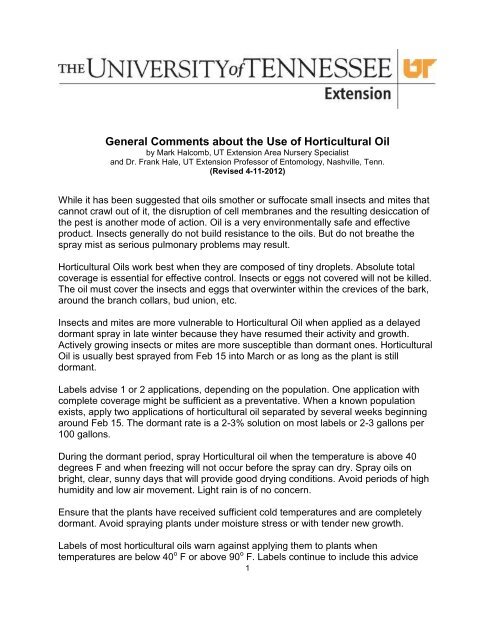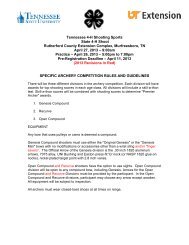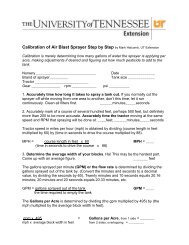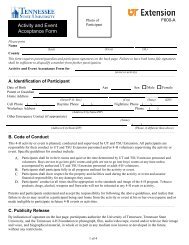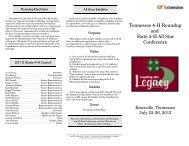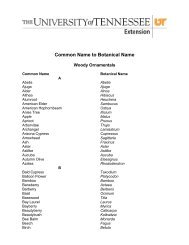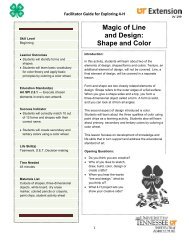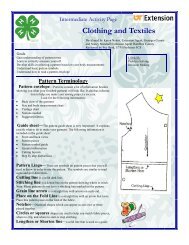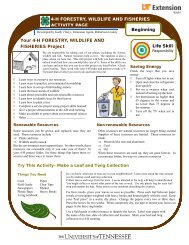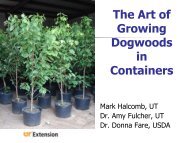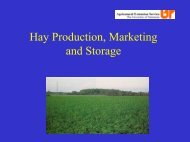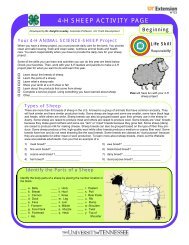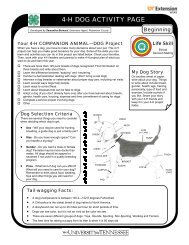General Comments about the Use of Horticultural Oil - UT Extension
General Comments about the Use of Horticultural Oil - UT Extension
General Comments about the Use of Horticultural Oil - UT Extension
- No tags were found...
You also want an ePaper? Increase the reach of your titles
YUMPU automatically turns print PDFs into web optimized ePapers that Google loves.
<strong>General</strong> <strong>Comments</strong> <strong>about</strong> <strong>the</strong> <strong>Use</strong> <strong>of</strong> <strong>Horticultural</strong> <strong>Oil</strong>by Mark Halcomb, <strong>UT</strong> <strong>Extension</strong> Area Nursery Specialistand Dr. Frank Hale, <strong>UT</strong> <strong>Extension</strong> Pr<strong>of</strong>essor <strong>of</strong> Entomology, Nashville, Tenn.(Revised 4-11-2012)While it has been suggested that oils smo<strong>the</strong>r or suffocate small insects and mites thatcannot crawl out <strong>of</strong> it, <strong>the</strong> disruption <strong>of</strong> cell membranes and <strong>the</strong> resulting desiccation <strong>of</strong><strong>the</strong> pest is ano<strong>the</strong>r mode <strong>of</strong> action. <strong>Oil</strong> is a very environmentally safe and effectiveproduct. Insects generally do not build resistance to <strong>the</strong> oils. But do not brea<strong>the</strong> <strong>the</strong>spray mist as serious pulmonary problems may result.<strong>Horticultural</strong> <strong>Oil</strong>s work best when <strong>the</strong>y are composed <strong>of</strong> tiny droplets. Absolute totalcoverage is essential for effective control. Insects or eggs not covered will not be killed.The oil must cover <strong>the</strong> insects and eggs that overwinter within <strong>the</strong> crevices <strong>of</strong> <strong>the</strong> bark,around <strong>the</strong> branch collars, bud union, etc.Insects and mites are more vulnerable to <strong>Horticultural</strong> <strong>Oil</strong> when applied as a delayeddormant spray in late winter because <strong>the</strong>y have resumed <strong>the</strong>ir activity and growth.Actively growing insects or mites are more susceptible than dormant ones. <strong>Horticultural</strong><strong>Oil</strong> is usually best sprayed from Feb 15 into March or as long as <strong>the</strong> plant is stilldormant.Labels advise 1 or 2 applications, depending on <strong>the</strong> population. One application withcomplete coverage might be sufficient as a preventative. When a known populationexists, apply two applications <strong>of</strong> horticultural oil separated by several weeks beginningaround Feb 15. The dormant rate is a 2-3% solution on most labels or 2-3 gallons per100 gallons.During <strong>the</strong> dormant period, spray <strong>Horticultural</strong> oil when <strong>the</strong> temperature is above 40degrees F and when freezing will not occur before <strong>the</strong> spray can dry. Spray oils onbright, clear, sunny days that will provide good drying conditions. Avoid periods <strong>of</strong> highhumidity and low air movement. Light rain is <strong>of</strong> no concern.Ensure that <strong>the</strong> plants have received sufficient cold temperatures and are completelydormant. Avoid spraying plants under moisture stress or with tender new growth.Labels <strong>of</strong> most horticultural oils warn against applying <strong>the</strong>m to plants whentemperatures are below 40 o F or above 90 o F. Labels continue to include this advice1
despite increasing evidence that this temperature range is conservatively narrow. It'smore important that <strong>the</strong> plant is not stressed for moisture and <strong>the</strong> humidity should below enough (45 to 65 percent) for oil to evaporate quickly.There are two basic petroleum oils: superior oil and <strong>the</strong> summer horticultural oil (thisincludes ultra-fine oil). Superior oil can only be used during <strong>the</strong> dormant period.Summer horticultural oil is more highly refined and less likely to cause phytotoxicity toplants. It can be used both as a dormant application and during <strong>the</strong> growing season.Ultra-fine oil is safer because it is even more highly refined (cleaner, fewer impurities)and can be applied when <strong>the</strong> temperature is in <strong>the</strong> 80’s or perhaps <strong>the</strong> 90’s if <strong>the</strong>humidity is less than 65 percent.Here are some <strong>of</strong> <strong>the</strong> overwintering insects and <strong>the</strong>ir eggs killed with <strong>Horticultural</strong> <strong>Oil</strong>:immature whiteflies;<strong>the</strong> white cottony pine bark adelgid (check <strong>the</strong> trunk and branches <strong>of</strong> white pine);Spider Mites, all types: broad, sou<strong>the</strong>rn red, two-spotted, rust mites and eriophyidmites on (hemlock, juniper, spruce, arborvitae, occasionally on burning bush & silvermaple);some types <strong>of</strong> overwintering eggs (<strong>the</strong> spiny witch hazel leaf gall aphid on birch and<strong>the</strong> white pine aphid);oak phylloxera (that causes oak leaves to wad up in July).Scale, all typesEuonymus scale on Manhattan and burning bushWhite peach tree scaleJapanese Maple Scale – see <strong>the</strong> handout “Scale- White peach & JapaneseMaple on <strong>the</strong> web site or request it for more specific details on control.Application<strong>Oil</strong> and water separate rapidly. Constant agitation is required. If a sprayer has been idlefor a few minutes, be sure to spray into <strong>the</strong> tank for a minute to ensure that <strong>the</strong> oil isthoroughly mixed or begin spraying several feet from <strong>the</strong> crop. O<strong>the</strong>rwise, <strong>the</strong> emulsionin <strong>the</strong> hose and tips will have separated and <strong>the</strong> first plants sprayed may receive purewater or pure oil. The oil might burn in some situations, especially if foliage is present.An airblast sprayer is more effective on foliar pests than on trunk pests. The airassistance provides better coverage with less water. The air also causes <strong>the</strong> leaves tomove <strong>about</strong> rapidly, allowing <strong>the</strong> pesticide to reach both sides.But an airblast does not achieve complete coverage <strong>of</strong> <strong>the</strong> trunks and branches. Thosethat attended <strong>the</strong> Sprayer Workshop in 2011 witnessed that.2
Producers have gotten use to successfully controlling foliar insects and fungi by drivingan airblast sprayer around multiple row blocks <strong>of</strong> 2 inch trees. Units I have checkedwere applying around 35 gallons <strong>of</strong> spray solution per acre.Making two trips around a block to double <strong>the</strong> spray volume per acre does not increase<strong>the</strong> coverage as you might think. Hanging water sensitive paper in <strong>the</strong> center <strong>of</strong> <strong>the</strong>block has shown that dry paper after <strong>the</strong> first application remained dry after <strong>the</strong> secondtrip around <strong>the</strong> block, while wet spots got wetter. <strong>Oil</strong> is only effective where absolutetotal coverage is achieved. Begin planting host crops <strong>of</strong> <strong>the</strong> more difficult to controlpests into 4 row blocks to improve spray coverage from existing airblast sprayers.There must be adequate pressure to blow <strong>the</strong> oil through <strong>the</strong> plants, from 2 sides,achieving total coverage. Air blast sprayers are great, but <strong>the</strong> output will have to beincreased to 60-80 gallons <strong>of</strong> spray solution per acre to obtain <strong>the</strong> degree <strong>of</strong> coveragerequired to control many pests with oil. (The required water volume will depend onfoliage density.)Airblast sprayers are available narrow enough to be driven in each middle to helpachieve better coverage in large blocks and for <strong>the</strong> more difficult to control pests, suchas <strong>the</strong> Japanese Maple Scale.HandgunA nursery may be forced to apply some pesticides with a handgun or backpack sprayerin blocks with more rows than an airblast sprayer can be effective in. Spray <strong>the</strong> sameplants while moving down <strong>the</strong> row from two directions, from <strong>the</strong> north and <strong>the</strong>n from <strong>the</strong>south.Caution<strong>Oil</strong> will remove <strong>the</strong> bluish blush from existing foliage on blue spruce but <strong>the</strong> new growthwill be normal.<strong>Oil</strong>-Sensitive PlantsVarious labels and entomologists suggest various plants as being susceptible to oilssuch as maples, particularly Japanese and red maple; hickories and black walnut;plume cedar (Cryptomeria japonica) and smoke tree (Cotinus coggygria). Redbud,junipers, cedars, spruce and Douglas firs are listed as being somewhat sensitive.Many <strong>of</strong> <strong>the</strong> precautions originate in nor<strong>the</strong>rn states. It may be that oils were appliedbefore plants became fully dormant one year, resulting in injury and <strong>the</strong> warning haspersisted ever since. Davey Tree Co. realized this 30 years ago.<strong>Use</strong> <strong>the</strong> more highly refined horticultural oils on <strong>the</strong> oil sensitive or even potentiallysensitive plants in <strong>the</strong> nursery and landscape instead <strong>of</strong> <strong>the</strong> less expensive superior oiltypically used for dormant applications.3
Labels <strong>of</strong> most horticultural oils warn against applying <strong>the</strong>m to plants whentemperatures are below 40 o F or above 90 o F. Labels continue to include this advicedespite increasing evidence that this temperature range is conservatively narrow. It'smore important that <strong>the</strong> plant is not stressed for moisture and <strong>the</strong> humidity should below enough (45 to 65 percent) for oil to evaporate quickly.Visit for more information:http://www.colostate.edu/Dept/CoopExt/4DMG/PHC/hortoil.htmmhalcomb@utk.edu phone 931-473-8484Comm/Insects/<strong>Oil</strong>/Hort <strong>Oil</strong> Handout 4-11-12Precautionary StatementTo protect people and <strong>the</strong> environment, pesticides should be used safely. This is everyone's responsibility,especially <strong>the</strong> user. Read and follow label directions carefully before you buy, mix, apply, store or dispose <strong>of</strong> apesticide. According to laws regulating pesticides, <strong>the</strong>y must be used only as directed by <strong>the</strong> label.DisclaimerThis publication contains pesticide recommendations that are subject to change at any time. The recommendationsin this publication are provided only as a guide. It is always <strong>the</strong> pesticide applicator's responsibility, bylaw, to read and follow all current label directions for <strong>the</strong> specific pesticide being used. The label always takesprecedence over <strong>the</strong> recommendations found in this publication.<strong>Use</strong> <strong>of</strong> trade or brand names in this publication is for clarity and information; it does not imply approval <strong>of</strong> <strong>the</strong>product to <strong>the</strong> exclusion <strong>of</strong> o<strong>the</strong>rs that may be <strong>of</strong> similar, suitable composition, nor does it guarantee or warrant<strong>the</strong> standard <strong>of</strong> <strong>the</strong> product. The author(s), <strong>the</strong> University <strong>of</strong> Tennessee Institute <strong>of</strong> Agriculture and University<strong>of</strong> Tennessee <strong>Extension</strong> assume no liability resulting from <strong>the</strong> use <strong>of</strong> <strong>the</strong>se recommendations..4


